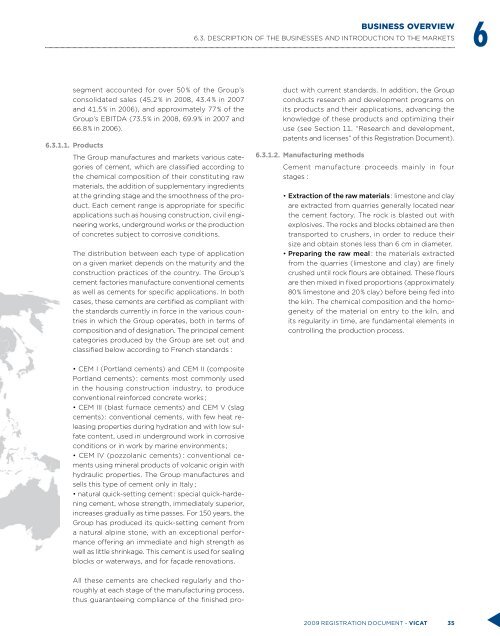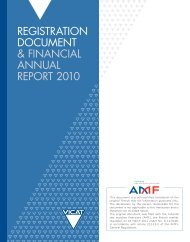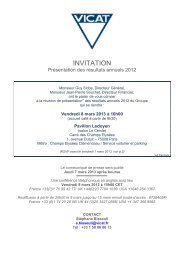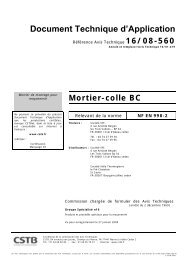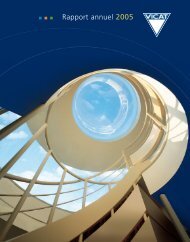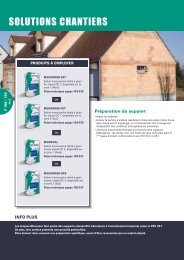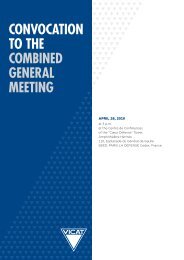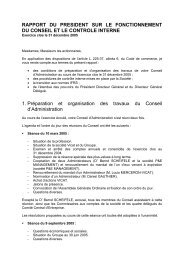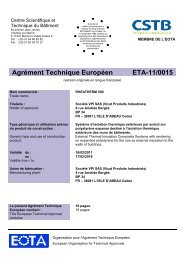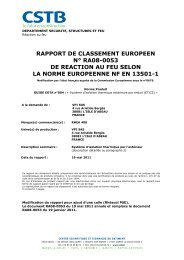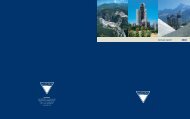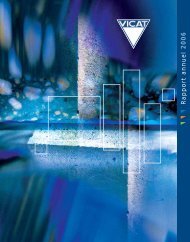6 - Vicat
6 - Vicat
6 - Vicat
- No tags were found...
Create successful ePaper yourself
Turn your PDF publications into a flip-book with our unique Google optimized e-Paper software.
BUSINESS OVERVIEW66.3. DESCRIPTION OF THE BUSINESSES AND INTRODUCTION TO THE MARKETSsegment accounted for over 50 % of the Group’sconsolidated sales (45.2 % in 2008, 43.4 % in 2007and 41.5 % in 2006), and approximately 77 % of theGroup’s EBITDA (73.5 % in 2008, 69.9 % in 2007 and66.8 % in 2006).6.3.1.1. ProductsThe Group manufactures and markets various categoriesof cement, which are classified according tothe chemical composition of their constituting rawmaterials, the addition of supplementary ingredientsat the grinding stage and the smoothness of the product.Each cement range is appropriate for specificapplications such as housing construction, civil engineeringworks, underground works or the productionof concretes subject to corrosive conditions.The distribution between each type of applicationon a given market depends on the maturity and theconstruction practices of the country. The Group’scement factories manufacture conventional cementsas well as cements for specific applications. In bothcases, these cements are certified as compliant withthe standards currently in force in the various countriesin which the Group operates, both in terms ofcomposition and of designation. The principal cementcategories produced by the Group are set out andclassified below according to French standards :All these cements are checked regularly and thoroughlyat each stage of the manufacturing process,thus guaranteeing compliance of the finished productwith current standards. In addition, the Groupconducts research and development programs onits products and their applications, advancing theknowledge of these products and optimizing theiruse (see Section 11. “Research and development,patents and licenses” of this Registration Document).6.3.1.2. Manufacturing methodsCement manufacture proceeds mainly in fourstages :• Extraction of the raw materials : limestone and clayare extracted from quarries generally located nearthe cement factory. The rock is blasted out withexplosives. The rocks and blocks obtained are thentransported to crushers, in order to reduce theirsize and obtain stones less than 6 cm in diameter.• Preparing the raw meal : the materials extractedfrom the quarries (limestone and clay) are finelycrushed until rock flours are obtained. These floursare then mixed in fixed proportions (approximately80 % limestone and 20 % clay) before being fed intothe kiln. The chemical composition and the homogeneityof the material on entry to the kiln, andits regularity in time, are fundamental elements incontrolling the production process.• CEM I (Portland cements) and CEM II (compositePortland cements) : cements most commonly usedin the housing construction industry, to produceconventional reinforced concrete works ;• CEM III (blast furnace cements) and CEM V (slagcements) : conventional cements, with few heat releasingproperties during hydration and with low sulfatecontent, used in underground work in corrosiveconditions or in work by marine environments ;• CEM IV (pozzolanic cements) : conventional cementsusing mineral products of volcanic origin withhydraulic properties. The Group manufactures andsells this type of cement only in Italy ;• natural quick-setting cement : special quick-hardeningcement, whose strength, immediately superior,increases gradually as time passes. For 150 years, theGroup has produced its quick-setting cement froma natural alpine stone, with an exceptional performanceoffering an immediate and high strength aswell as little shrinkage. This cement is used for sealingblocks or waterways, and for façade renovations.2009 registration document - VICAT 35


